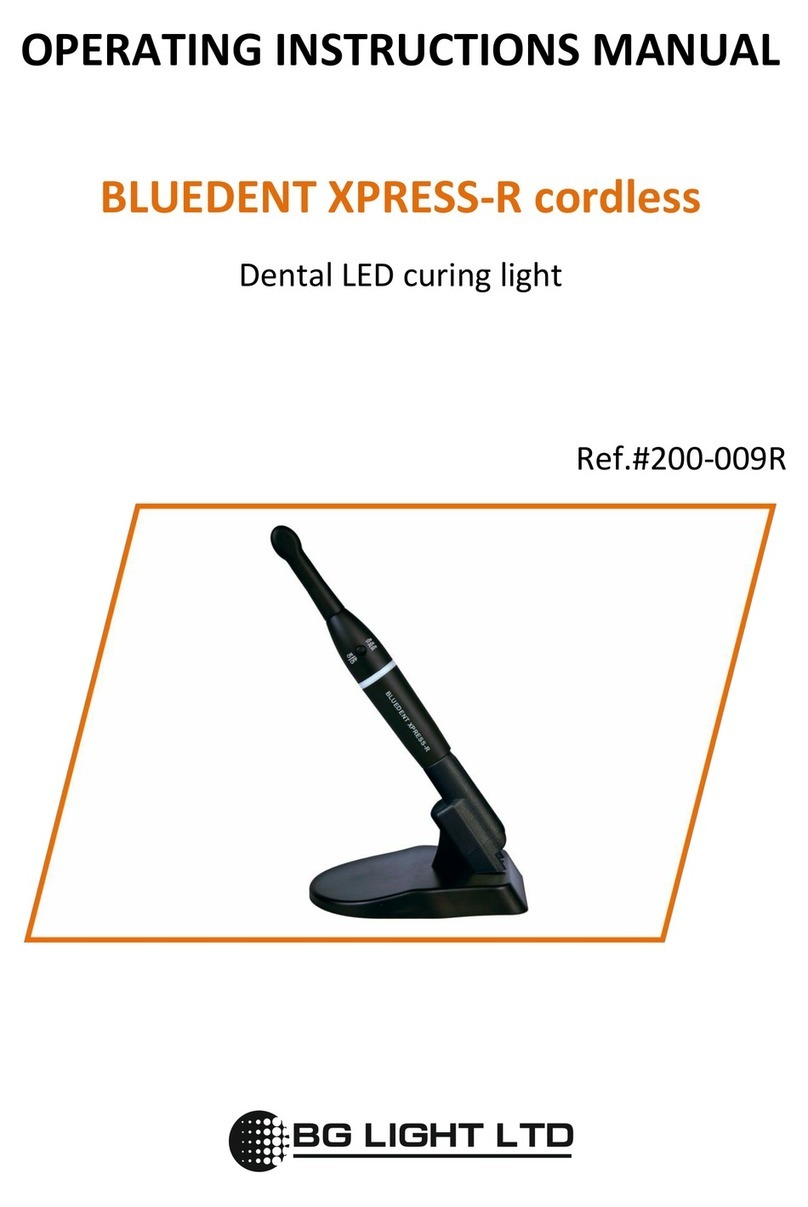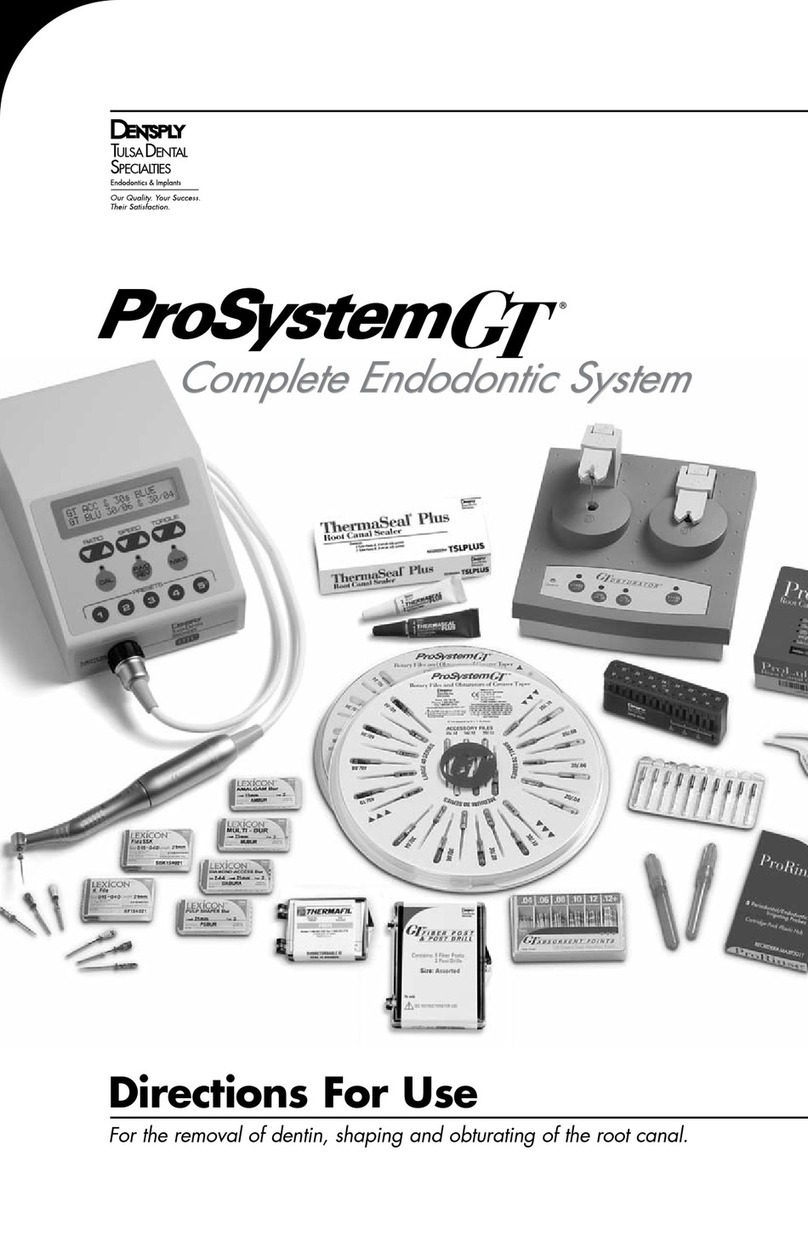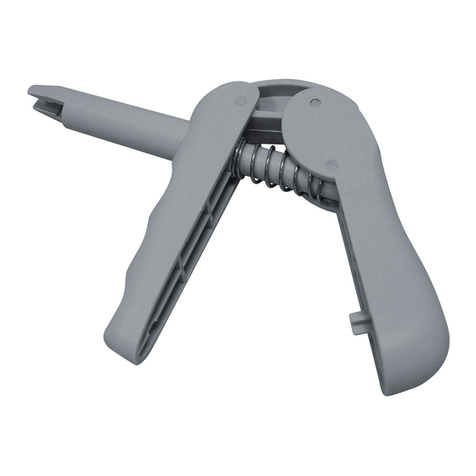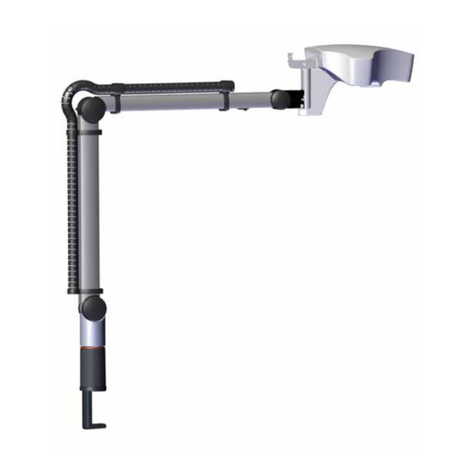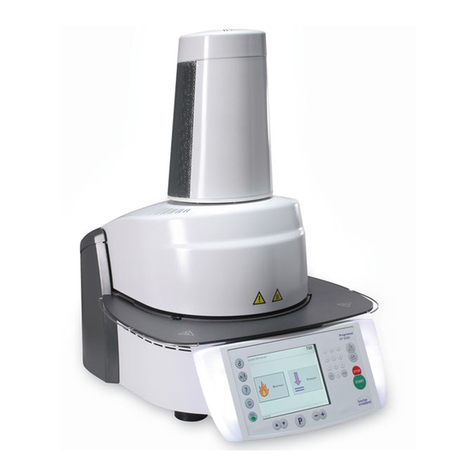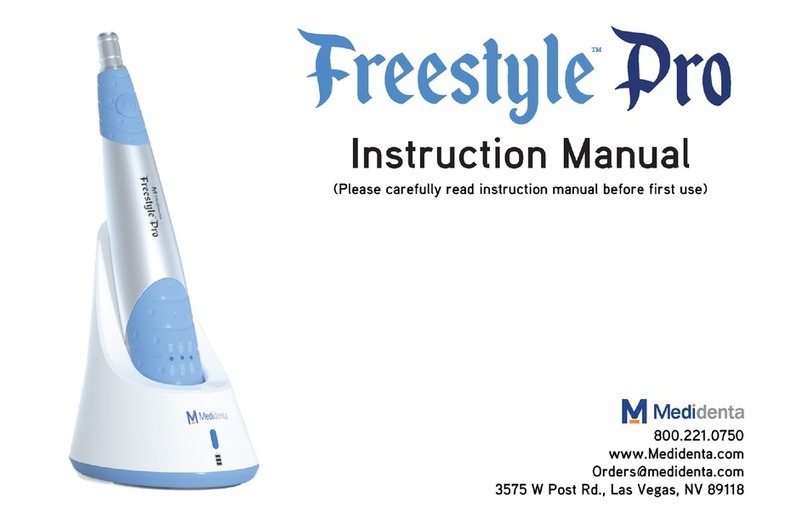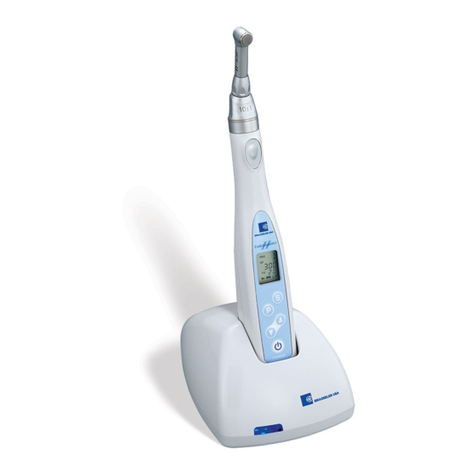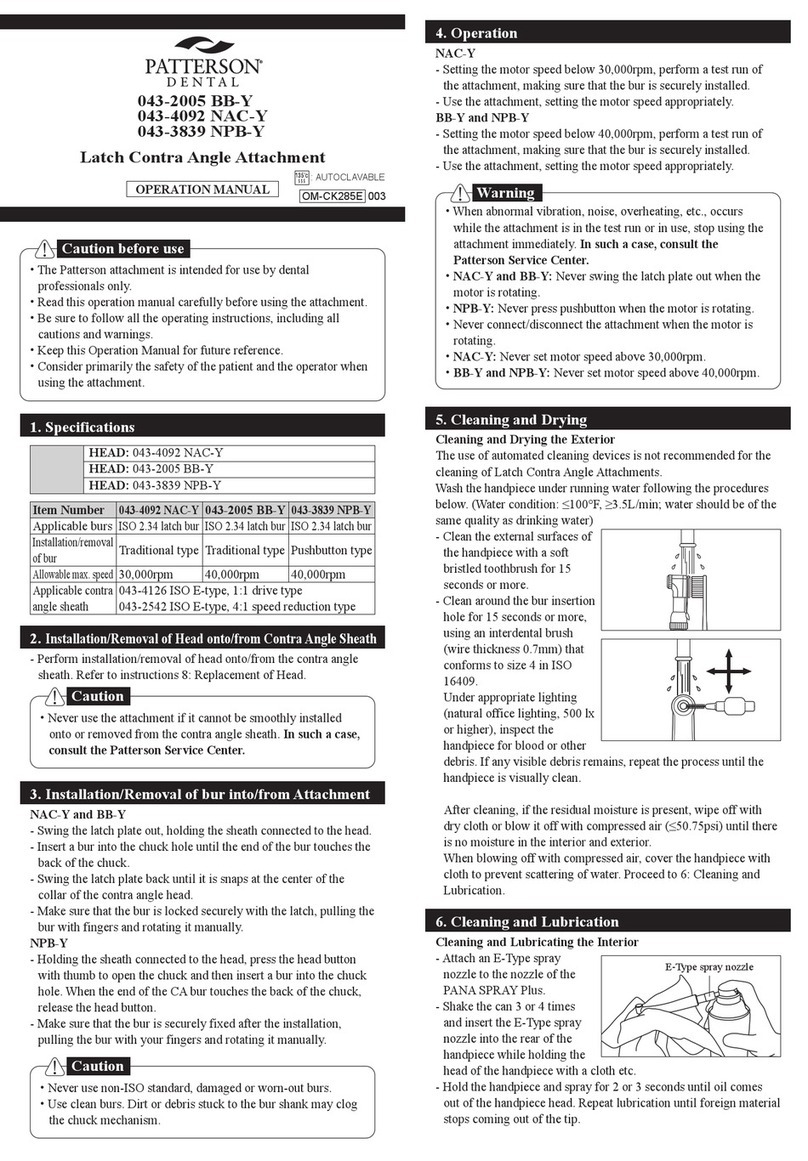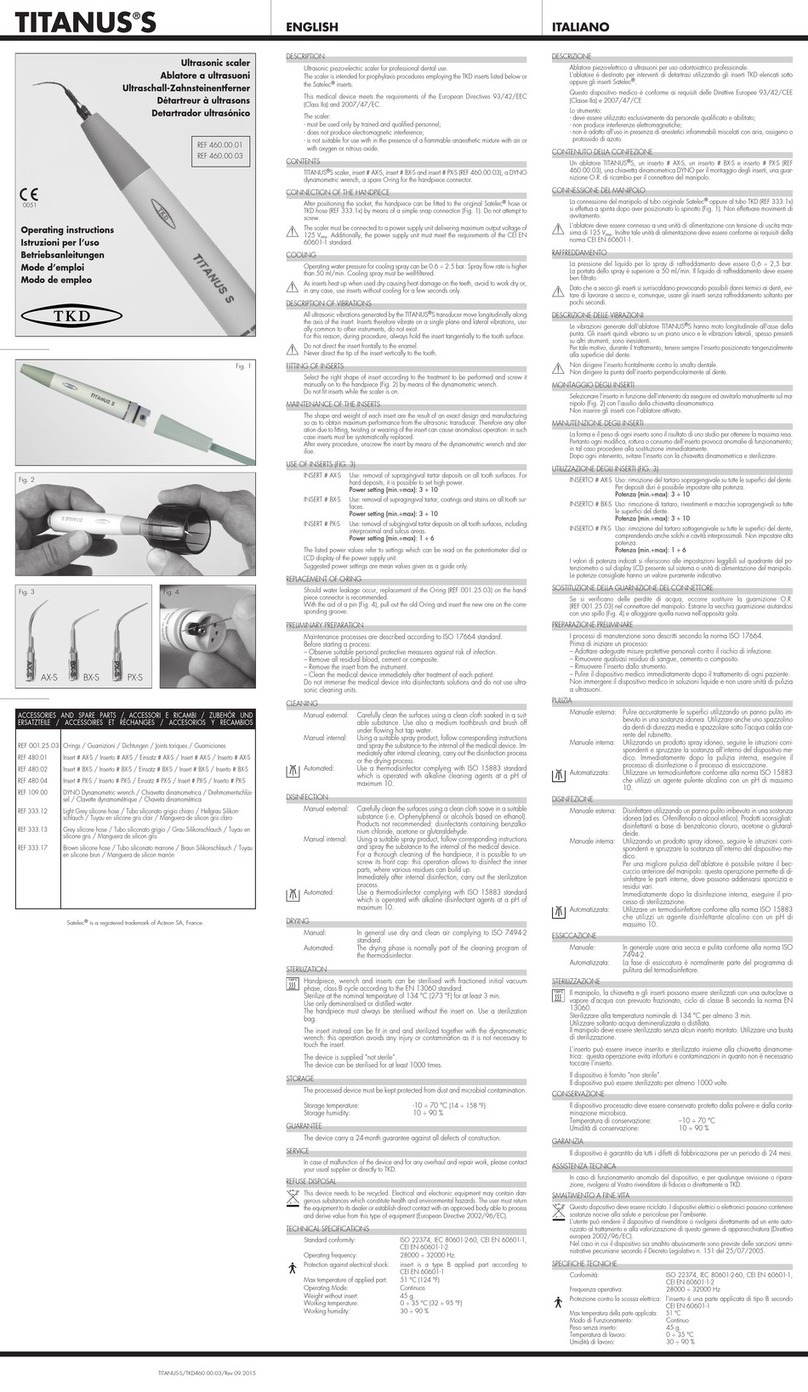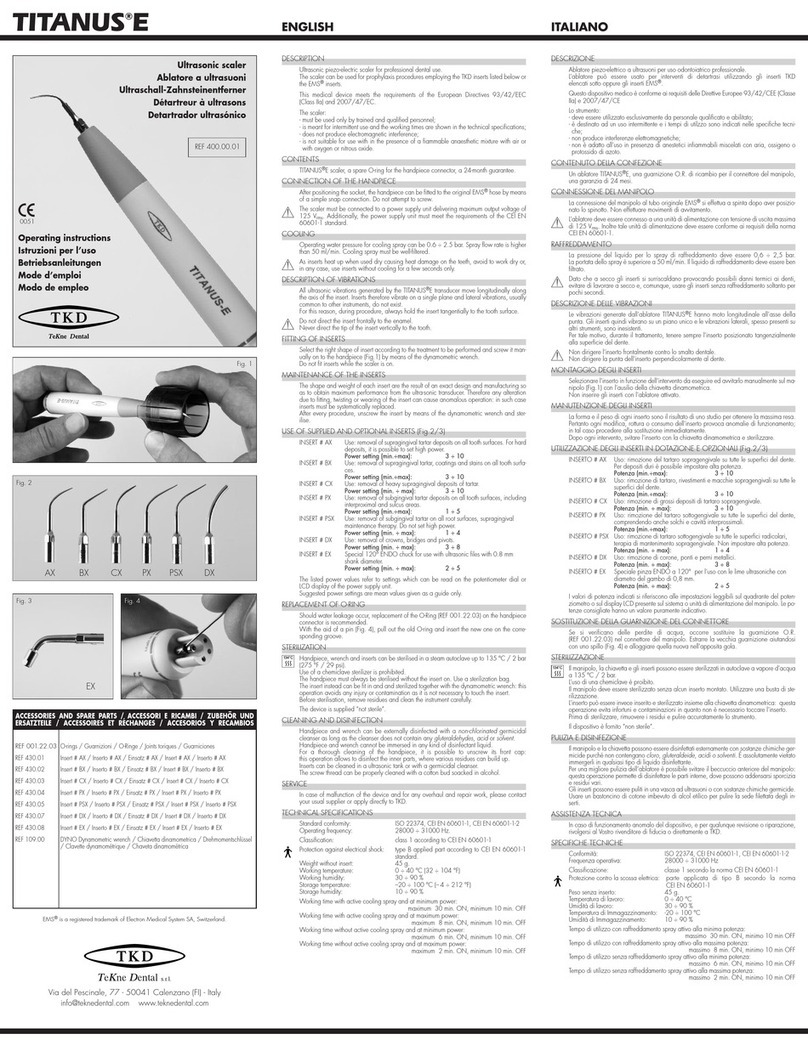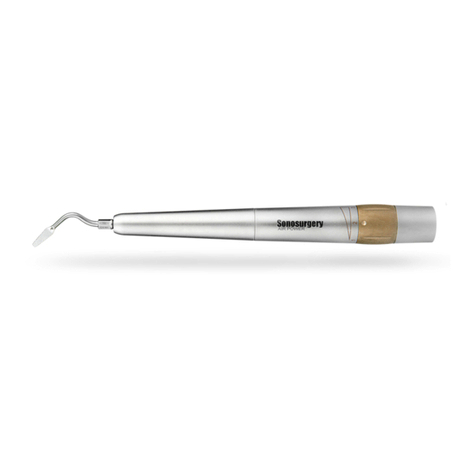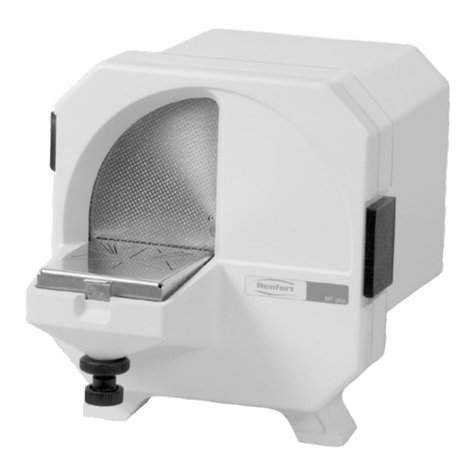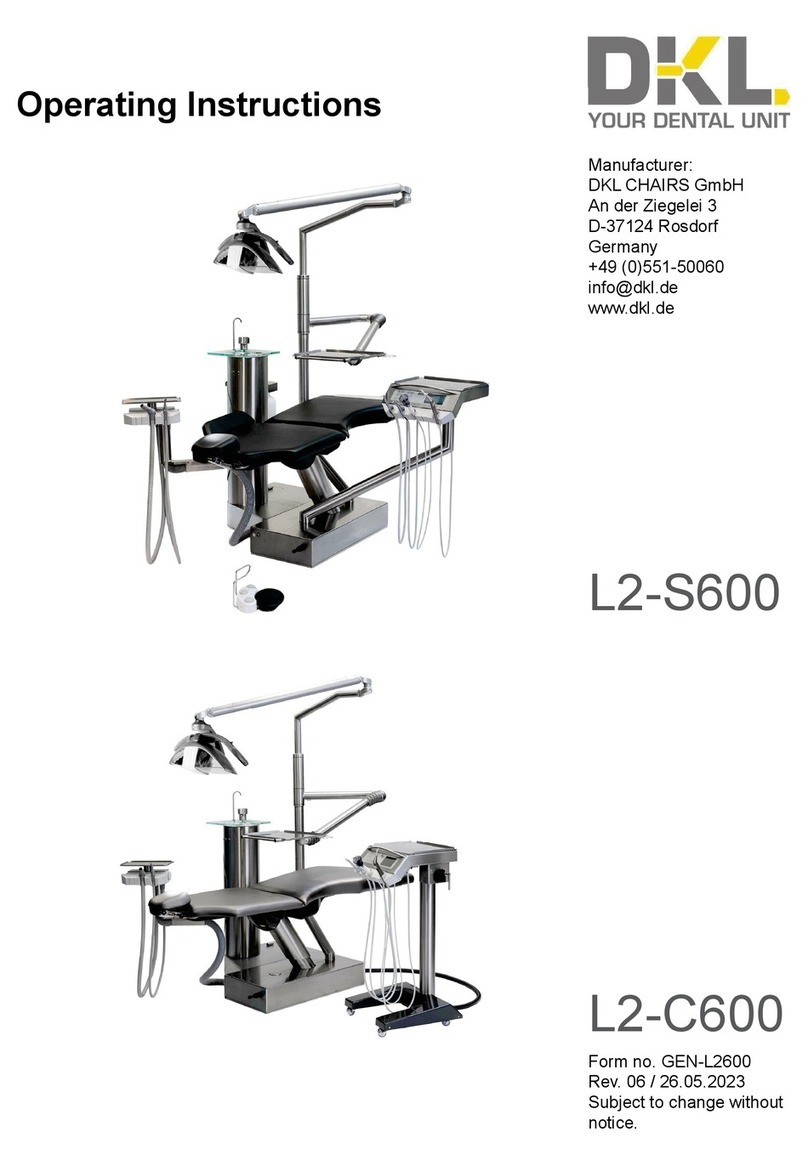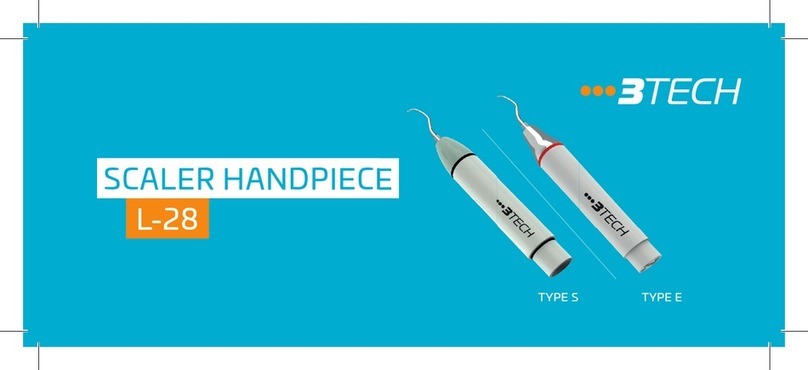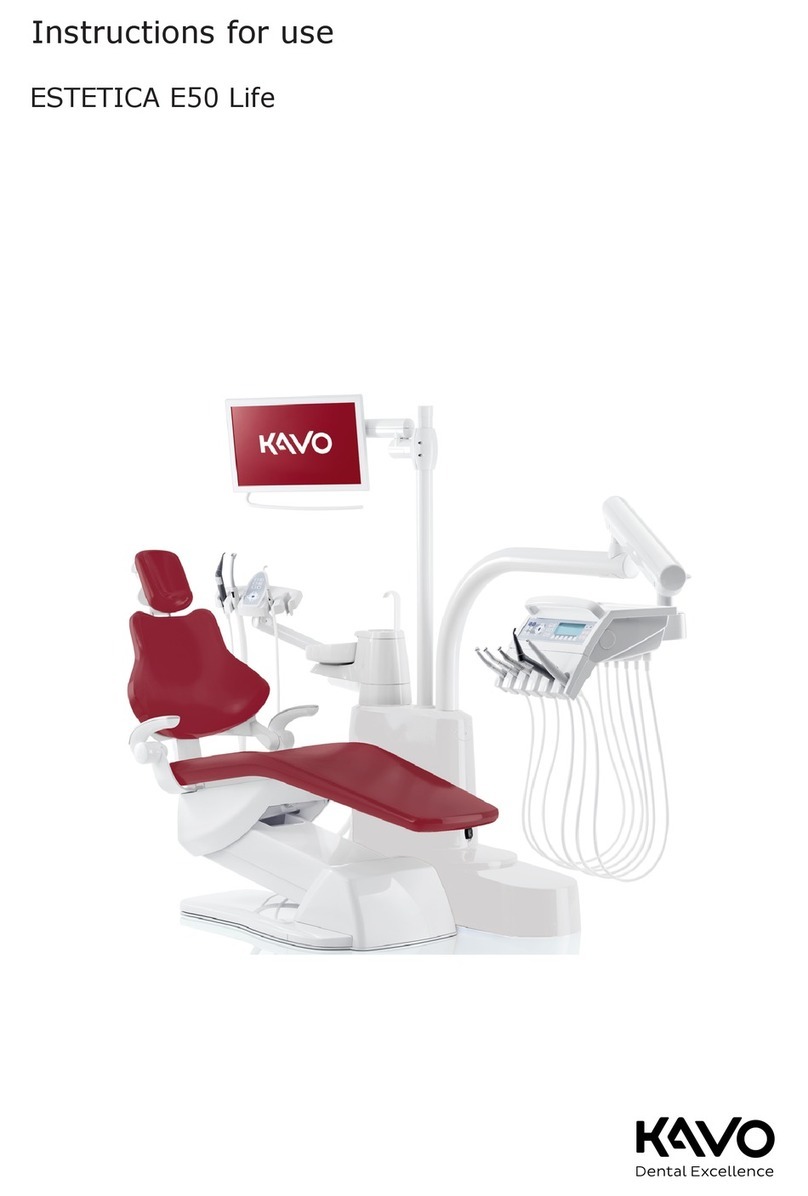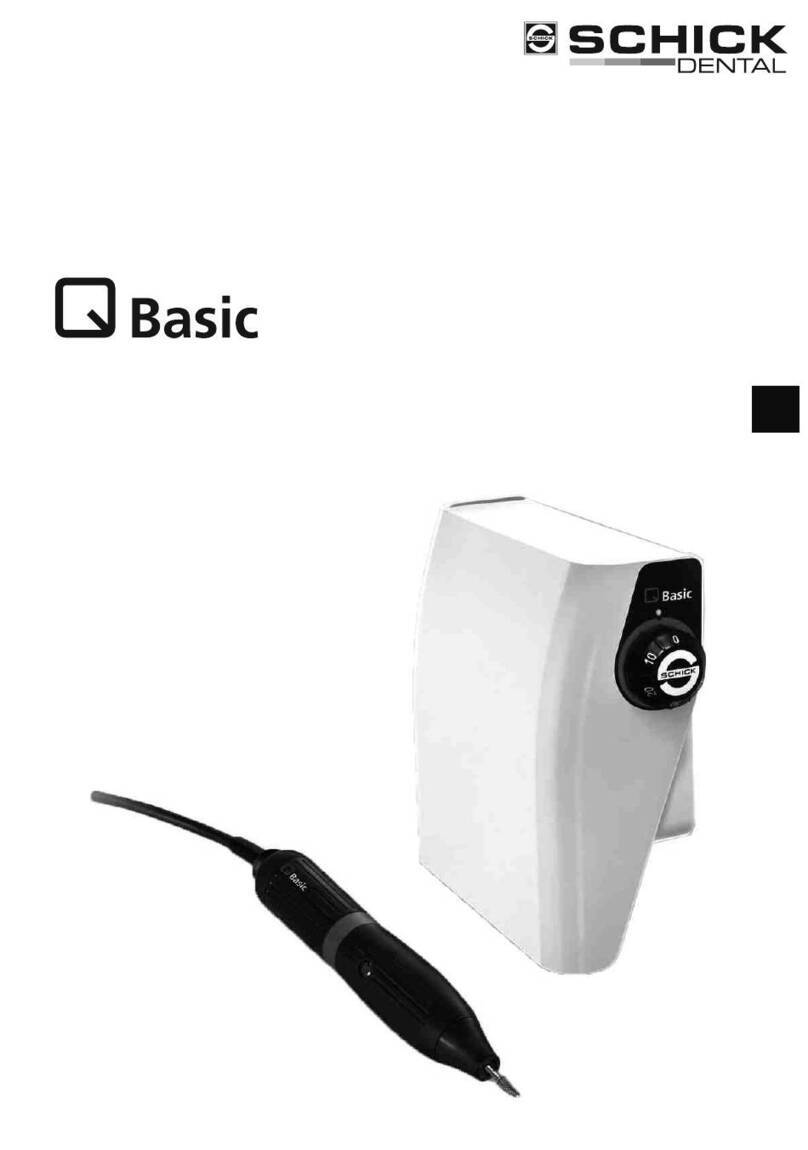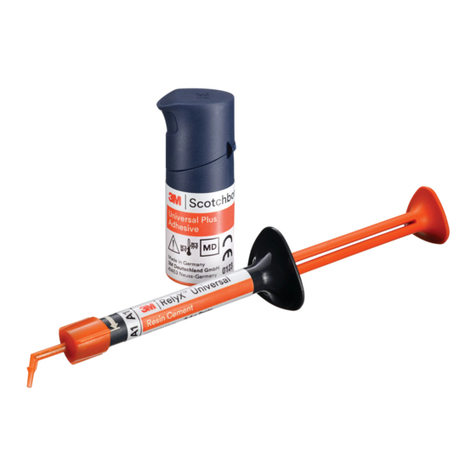
DEUTSCH
BESCHREIBUNG
Piezoelektrischer Ultraschall-Zahnsteinentferner für den professionellen zahnmedizinischen
Gebrauch.
Durch Gebrauch der Einsätze TKD oder der Einsätze EMS®kann der Zahnsteinentferner für
Eingriffe zur Zahnsteinentfernung verwendet werden.
Dieses medizintechnische Produkt ist konform mit den Anforderungen den Europäischen
Richtlinien 93/42/EWG (Klasse IIa) und 2007/47/EG.
Das Instrument:
- darf ausschließlich von befugten Fachkräften verwendet werden;
- ist für den intermittierenden Betrieb bestimmt; die Zeiten sind unter den technischen Daten
angegeben;
- erzeugt keine elektromagnetischen Störungen;
- ist nicht für den Einsatz in Präsenz von entflammbaren, mit Luft, Sauerstoff oder Stickstoffmon-
oxid vermischten Anästhetika geeignet.
PACKUNGSINHALT
Ein Zahnsteinentferner TITANUS®E, ein Einsatz #A , ein Einsatz #B und ein Einsatz #P
(REF 410.00.03), einen Drehmomentschlüssel DYNO, eine OR-Ersatzdichtung für den Steck-
verbinder des Handstücks.
ANSCHLUSS DES HANDSTÜCKS
Der Anschluss des Handstück an den Originalschlauch
EMS®
oder Schlauch TKD
(REF 332.1x) erfolgt durch Druck (einrastend), nachdem der Stecker positioniert worden ist
(Abb.1).
Keine Schraubbewegungen ausführen.
Der Zahnsteinentferner muss an eine Versorgungseinheit mit max. Ausgangsspannung von
125 Vrms angeschlossen werden. Darüber hinaus muss die Versorgungseinheit die Anforde-
rungen der Norm CEI EN 60601-1 erfüllen.
KÜHLUNG
Der Druck der Sprayflüssigkeit zur Kühlung muss 0,6 ÷ 2,5 bar betragen.
Mindestdurchsatz des Sprays: 50 ml/min. Die Kühlflüssigkeit muss gut gefiltert sein.
Da sich die Einsätze im Trockenlauf überhitzen und mögliche thermische Schäden an den
Zähnen verursachen, ist ein Arbeiten im Trockenlauf zu vermeiden. Die Einsätze ohne Kühlung
grundsätzlich nur für einige Minuten verwenden.
BESCHREIBUNG DER SCHWINGUNGEN
Die vom Zahnsteinentferner TITANUS®E erzeugten Schwingungen haben eine Längsbewe-
gung zur Achse des Einsatzes.
Die Einsätze vibrieren folglich in einer einzigen Ebene. Es existieren keine seitlichen Vibratio-
nen, wie sie häufig an anderen Instrumenten vorhanden sind. Aus diesem Grund muss wäh-
rend der Behandlung der Einsatz immer tangential zur Zahnoberfläche gehalten werden.
Den Einsatz nicht frontal auf den Zahnschmelz richten.
Die Spitze des Einsatzes nicht rechtwinkelig zum Zahn richten (falls nicht spezifisch angege-
ben).
MONTAGE DER EINSÄTZE
Den Einsatz aufgrund des auszuführenden Eingriffs auswählen und von Hand am Handstück
aufschrauben (Abb. 2). Dazu einen Drehmomentschlüssel verwenden.
Keine Einsätze bei aktiviertem Zahnsteinentferner einsetzen.
INSTANDHALTUNG DER EINSÄTZE
Form und Gewicht eines jeden Einsatzes sind das Ergebnis einer Studie zur Erzielung maxi-
maler Leistungen.
Aus diesem Grund verursacht jegliche Änderung durch Einsetzen, Drehen oder Abnutzung
des Einsatzes Betriebsstörungen. In diesem Fall ist der Einsatz sofort auszutauschen.
Nach einem jeden Eingriff den Einsatz mit dem Drehmomentschlüssel lösen und desinfizie-
ren.
GEBRAUCH DER MITGELIEFERTEN UND OPTIONALEN EINSÄTZE (ABB.3/4)
EINSATZ #A Gebrauch: Entfernen von supragingivalem Zahnstein auf allen Zahnober-
flächen
Leistung (min.÷max.): 3 ÷ 10
EINSATZ #B Gebrauch: Entfernen von Zahnstein, Belägen und supragingivalen Verfär-
bungen auf allen Zahnoberflächen
Leistung (min.÷max.): 3 ÷ 10
EINSATZ #C Gebrauch: Entfernen von großen supragingivalem Zahnsteinablagerungen
an den Vorderzähnen, Entfernen von Zahnzementen; die flache Spitze des
Einsatzes kann an den labialen Oberflächen verwendet werden.
Leistung (min.÷max.): 3 ÷ 10
EINSATZ #P Gebrauch: Entfernen von supragingivalem oder subgingivalem Zahnstein
auf allen Zahnoberflächen, insbesondere in den interproximalen Kavitäten
und Furchen.
Leistung (min.÷max.): 1 ÷ 6
EINSATZ #PS Gebrauch: Entfernen von subgingivalem Zahnstein auf den Wurzeloberflä-
chen, Wurzelkürettage, supragingivale Behandlungen zur Zahnerhaltung.
Keine hohe Leistung einstellen.
Leistung (min.÷max.): 1 ÷ 5
EINSATZ #D Gebrauch: Entfernen von Kronen und Brücken, Abschleifen von Befesti-
gungszement auf harten Materialien.
Leistung (min.÷max.): 3 ÷ 8
EINSATZ #E 120° Spezialzange ENDO für die Verwendung von Ultraschallfeilen mit
Schaftdurchmesser 0,8 mm. Keine hohe Leistung einstellen.
Leistung (min.÷max.): 1 ÷ 4
Die angegebenen Leistungswerte beziehen sich auf die auf der Skala des Potentiometers oder
auf dem an der Versorgungseinheit des Handstücks vorhandenen LCD-Display ablesbaren
Einstellungen.
Bei den empfohlenen Leistungen handelt es sich um reine Richtwerte.
AUSTAUSCH DER DICHTUNG DES STECKVERBINDERS
Falls Wasser ausläuft, muss die OR-Dichtung (REF 001.22.03) im Steckverbinder des Hand-
stücks ausgetauscht werden.
Die alte Dichtung mit Hilfe einer Nadel (Abb. 5) herausziehen und die neue in der dafür vor-
gesehenen Rille einlegen.
VORBEREITUNG VOR DEM GEBRAUCH
Die Wartungsverfahren sind gemäß ISO 17664 beschrieben.
Vor Beginn eines Verfahrens:
– Geeignete persönliche Schutzmaßnahmen gegen Infektionsgefahr ergreifen.
– Jegliche Blut-, Zement- oder Compositereste entfernen.
– Dem Einsatz aus dem Instrument entfernen.
– Die medizinische Vorrichtung nach jeder Behandlung sofort reinigen.
Die medizinische Vorrichtung nicht in Lösungen tauchen und keine Ultraschall-Reinigungsvor-
richtungen verwenden.
REINIGUNG
Manuell außen: Die Oberflächen grundlich mit einem sauberen, mit einem geeigneten Pro-
dukt getränkten Tuch reinigen. Daruber hinaus mit einer Zahnburste mit mitt-
lerer Borstenhärte unter fließendem, warmem Leitungswasser bursten.
Manuell innen: Ein geeignetes Sprayprodukt verwenden. Die entsprechenden Anleitungen
befolgen und das Produkt ins Innere der medizinischen Vorrichtung spruhen.
Nach der Reinigung innen sofort desinfizieren oder trocknen.
Automatisch: Einen Thermodesinfektor gemäß ISO 15883 verwenden. Nur geeignete
Reinigungsmittel (pH 10 maximal).
DESINFEKTION
Manuell außen: Mit einem sauberen, mit einem geeigneten Produkt getränkten Tuch desin-
fizieren (z.B. o-Phenylphenol oder Äthylalkohol). Nicht empfohlene Pro-
dukte: Desinfektionsmittel auf der Basis von Benzalkoniumchlorid, Aceton
oder Glutaraldehyd.
Manuell innen: Ein geeignetes Sprayprodukt verwenden. Die entsprechenden Anleitungen
befolgen und das Produkt ins Innere der medizinischen Vorrichtung spruhen.
Nach der Desinfektion innen sofort sterilisieren.
Automatisch: Einen Thermodesinfektor gemäß ISO 15883 verwenden. Nur geeignete
Desinfektionsmittel (pH 10 maximal).
TROCKNUNG
Manuell: Generell trockene und saubere Luft gemäß ISO 7494-2 verwenden.
Automatisch: Die Trocknungsphase ist in der Regel Teil des Reinigungsprogramms des
Thermodesinfektors.
STERILISATION
Das Handstück, der Schlüssel und die Einsätze können im Autoklav bei einer Wasserdampftempe-
ratur von 134 °C / 2 bar sterilisiert werden.
Der Gebrauch eines Chemiklaven ist verboten.
Das Handstück muss immer ohne montierten Einsatz sterilisiert werden.
Einen Sterilisationsbeutel verwenden.
Der Einsatz kann hingegen zusammen mit dem Drehmomentschlüssel eingelegt und sterilisiert wer-
den: Dadurch werden Verletzungen und Kontamination vermieden, da der Einsatz nicht berührt
werden muss.
Vor der Sterilisation die Rückstände beseitigen und das Instrument gründlich reinigen.
Die Vorrichtung wird „nicht steril“ geliefert.
Die Vorrichtung fur mindestens 1000 mal sterilisiert werden.
AUFBEWAHRUNG
Die behandelte Vorrichtung muss vor Staub und mikrobischer Verunreinigung geschutzt aufbe-
wahrt werden.
Lagerungstemperatur: –10 ÷ 70 °C
Lagerungsfeuchtigkeit: 10 ÷ 90 %
GARANTIE
Fur die Vorrichtung wird fur alle Herstellungsfehler fur einen Zeitraum von 24 Monaten
garantiert.
TECHNISCHER KUNDENDIENST
Bei Störungen der Vorrichtung sowie für jeden beliebigen Eingriff zur Überholung oder Repa-
ratur wenden Sie sich bitte an Ihren Vertrauenshändler oder direkt an TKD.
ENTSORGUNG
Diese Vorrichtung muss recycelt werden. Elektrische oder elektronische Vorrichtungen können
gesundheitsschädliche und umweltgefährdende Stoffe enthalten. Der Benutzer kann die Vor-
richtung dem Händler zurückgeben oder sich direkt an eine für die Behandlung und Wieder-
verwertung dieser Art von Gerät wenden (Europäische Richtlinie 2002/96/EG).
TECHNISCHE DATEN
Konformität: ISO 22374,
IEC 80601-2-60,
CEI EN 60601-1, CEI EN
60601-1-2
Betriebsfrequenz: 27000 ÷ 32000 Hz
Schutz gegen Stromschlag: Einsatz ist Anwendungsteil vom Typ B gemäß CEI EN
60601-1
Max Anwendungsteiltemperatur:
51 °C
Betriebsart: Dauerbetrieb
Gewicht ohne Einsatz: 45 g
Betriebstemperatur: 0 ÷ 35 °C
Betriebsfeuchtigkeit: 30 ÷ 90 %
DESCRIPCIÓN
Detartrador piezo-eléctrico ultrasónico para un uso odontológico profesional.
El detartrador se puede usar para intervenciones de detartraje utilizando los insertos TKD enume-
rados a continuación o los insertos EMS®.
Este dispositivo médico cumple con los requisitos de las Directivas Europeas 93/42/CEE (Clase
IIa) y 2007/47/CE.
El dispositivo:
- debe ser utilizado exclusivamente por personal cualificado e idóneo;
- está destinado para un uso intermitente y los tiempos de utilización están indicados en las espe-
cificaciones técnicas;
- no produce interferencias electromagnéticas;
- no es conveniente su uso en presencia de anestésicos inflamables mezclados con aire, oxígeno
o protóxido de nitrógeno;
DOTACIÓN
Un detartrador TITANUS®E, un inserto #A , un inserto #B y un inserto #P (REF 410.00.03),
una chaveta dinamométrica DYNO para el montaje de los insertos, una guarnición O.R. de
recambio para el conector de la pieza de mano.
CONE IÓN DE LA PIEZA DE MANO
La conexión de la pieza de mano a la manguera original EMS®o a la manguera TKD
(REF 332.1x) se efectúa a presión después de haber posicionado la espiga (Fig.1). No efec-
tuar movimientos de rotación.
El detartrador tiene que ser conectado a una unidad de alimentación que tenga una tensión de
salida máxima de 125 Vrms. Además, dicha unidad de alimentación debe cumplir con los requi-
sitos de la norma CEI EN 60601-1.
ENFRIAMIENTO
La presión del líquido para el spray de enfriamiento debe ser 0,6 ÷ 2,5 bar. El flujo minimo es
50 ml/min. El líquido de enfriamiento debe ser bien filtrado.
Dado que en seco los insertos se recalientan provocando posibles daños térmicos a los dientes,
evitar trabajar en seco y, de todas formas, usar los insertos sin enfriamiento sólo por unos segun-
dos.
DESCRIPCIÓN DE LAS VIBRACIONES
Las vibraciones generadas por el detartrador TITANUS®E tienen un movimiento longitudinal al eje
de la punta. Los insertos, por consiguiente, vibran sobre un plano único y las vibraciones laterales,
a menudo presentes en otros instrumentos, son inexistentes.
Por eso, durante el tratamiento, tener siempre el inserto posicionado tangencialmente a la superficie
del diente.
No orientar el inserto de frente contra el esmalte dental.
No orientar la punta del inserto perpendicularmente al diente.
MONTAJE DE LOS INSERTOS
Seleccionar el inserto en función de la intervención por efectuar y atornillarlo manualmente a la
pieza de mano (Fig.2) mediante la chaveta dinamométrica.
No introducir los insertos con el detartrador activado.
MANTENIMIENTO DE LOS INSERTOS
La forma y el peso de cada uno de los insertos son el resultado de un estudio para obtener el má-
ximo rendimiento. Por lo tanto, cualquier modificación, rotura o desgaste de los insertos provoca
anomalías del funcionamiento: en estos casos proceder a la sustitución inmediatamente.
Después de cada intervención, destornillar el inserto con la chaveta dinamométrica y esterilizar.
USO DE LOS INSERTOS EN DOTACIÓN Y OPCIONALES (Fig.3/4)
INSERTO #A Uso: remoción del sarro supragingival en todas las superficies del diente.
Para depósitos duros es posible seleccionar alta potencia
Potencia (min.÷max): 3 ÷ 10
INSERTO #B Uso: remoción del sarro, rivestimientos y manchas supragingivales en todas
las sperficies del diente.
Potencia (min.÷max): 3 ÷ 10
INSERTO #C Uso: remoción de los depósitos supragingivales importantes de los dientes
anteriores. Puede emplearse para la remoción de los cementos ortodonticos.
Potencia (min.÷max): 3 ÷ 10
INSERTO #P Uso: remoción del sarro subgingival en todas las superficies del diente, com-
prendiendo tambien los surcos y cavidades interproximales.
Potencia (min.÷max): 1 ÷ 6
INSERTO #PS Uso: remoción fine del sarro subgingival de la superficie de las raízes den-
tales, terapia de mantenimento supragingival. No seleccionar alta potencia.
Potencia (min.÷max): 1 ÷ 5
INSERTO #D Uso: remoción de coronas y puentes, demolición de cementación sobre ma-
teriales duros.
Potencia (min.÷max): 3 ÷ 8
INSERTO #E Pinza especial ENDO destinada a uso con limas ultrasonica con 0,8 mm
de diàmetro. No seleccionar alta potencia
Potencia (min.÷max):
1 ÷ 4
Los valores de potencia indicados se refieren a los aduste legibles en el cuadrante del potenció-
metro o en el display LCD presente en el sistema o unidad de alimentación de la pieza de mano.
Las potencias aconsejadas tienen un valor puramente indicativo.
SUSTITUCIÓN DE LA GUARNICIÓN DEL CONECTOR
Si se verifican unas pérdidas de agua, hay que sustituir la guarnición O.R. (REF 001.22.03) en
el conector de la pieza de mano. Extraer la vieja guarnición ayudándose de una aguja (Fig.5) y
colocar la nueva en la ranura correspondiente.
PREPARACIÓN PRELIMINAR
Los procesos de mantenimiento están descritos según la norma ISO 17664.
Antes de empezar un proceso:
–Adoptar adecuadas medidas protectivas personales contra los riesgos de infección.
–Remover cualquier residuo de sangre, cemento o compuesto.
– Remover el inserto del instrumento.
–Limpiar el dispositivo médico inmediatamente después del tratamiento de cada paciente.
No sumergir el dispositivo médico en soluciones líquidas y no utilizar unidades de limpieza
por ultrasonidos.
LIMPIEZA
Manual externa: Limpiar esmeradamente las superficies utilizando un paño limpio em-
papado en una sustancia idónea. Utilizar también un cepillo de dientes
de media dureza y cepillar bajo el agua corriente caliente del grifo.
Manual interna: Empleando un producto spray idóneo, seguir las instrucciones corres-
pondientes y pulverizar la sustancia en el interior del dispositivo médico.
Inmediatamente después de la limpieza interior, ejecutar el proceso de
desinfección o el proceso de secamiento.
Automatizada: Utilizar un termodesinfector conforme con la norma ISO 15883.
Utilizar un agente limpiador alcalino a un pH de máximo 10.
DESINFECCIÓN
Manual externa: Desinfectar utilizando un paño limpio empapado en una sustancia idó-
nea (por ejemplo: o-fenilfenolo o alcohol etílico). Productos desaconse-
jados: desinfectantes a base de cloruro de benzalconio, acetona o
glutaraldehído.
Manual interna: Utilizando un producto spray idóneo, seguir las instrucciones correspon-
dientes y pulverizar la sustancia en el interior del dispositivo médico.
Inmediatamente después de la desinfección interior, ejecutar el proceso
de esterilización.
Automatizada: Utilizar un termodesinfector conforme con la norma ISO 15883.
Utilizar un agente desinfectante alcalino a un pH de máximo 10.
SECAMIENTO
Manual:
En general utilizar aire seco y limpio conforme con la norma ISO 7494-2.
Automatizada: La fase de secamiento normalmente forma parte del programa de
limpieza del termodesinfector.
ESTERILIZACIÓN
La pieza de mano, la chaveta y los insertos pueden ser esterilizados en autoclave de vapor de agua a
134 °C / 2 bares.
El uso de chemiclave está prohibido.
La pieza de mano se debe esterilizar siempre sin algún inserto montado. Utilizar una bolsa de esteriliza-
ción.
El inserto, al contrario, se puede introducir y esterilizar con la chaveta dinamométrica: esta operación
evita accidentes y contaminaciones ya que no es necesario tocar el inserto.
Antes de esterilizar, remover los residuos y limpiar cuidadosamente el instrumento.
El dispositivo se suministra “no estéril”.
El dispositivo se puede esterilizar por lo menos 1000 veces.
CONSERVACIÓN
El dispositivo sometido al proceso debe ser conservado protegido del polvo y de la conta-
minación micróbica.
Temperatura de almacenamiento: –10 ÷ 70 °C
Humedad de almacenamiento: 10 ÷ 90 %
GARANTÍA
El dispositivo está garantizado de todos los defectos de fabricación por un período de 24
meses.
ASISTENCIA TÉCNICA
En caso de funcionamento anómalo del dispositivo o para cualquier revisión o reparación,
dirigirse a su distribuidor o directamente a TKD.
ELIMINACIÓN AL FINAL DE LA VIDA
Este dispositivo debe ser reciclado. Los dispositivos eléctricos o electrónicos pueden contener
sustancias perjudiciales para la salud y peligrosas para el medio ambiente. El usuario puede
devolver el dispositivo al revendedor o dirigirse directamente a un ente autorizado al trata-
miento y a la valorización de este tipo de aparatos (Directiva europea 2002/96/EC).
DATOS TÉCNICOS
Conformidad: ISO 22374,
IEC 80601-2-60,
CEI EN 60601-1, CEI
EN 60601-1-2
Frecuencia de vibración: 27000 ÷ 32000 Hz
Protección contra la descarga eléctrica: El inserto es una parte aplicada de tipo B según la
norma CEI EN 60601-1
Temperatura máxima de la parte aplicada:
51 °C
Modo de funcionamiento: continuo
Peso sin inserto: 45 g.
Temperatura de empleo: 0 ÷ 35 °C
Humedad de empleo: 30 ÷ 90 %
ESPAÑOL
DESCRIPTION
Détartreur piézoélectrique à ultrasons pour un usage dentaire professionnel.
Le détartreur peut être utilisé pour des interventions de détartrage en utilisant les inserts TKD indiqués
ensuite ou les inserts EMS®.
Ce dispositif médical est conforme aux qualités requises par les Directives Européennes
93/42/CEE (Classe IIa) et 2007/47/CE.
Le dispositif:
– doit être utilisé exclusivement par du personnel qualifié et qui a obtenu un certificat d’aptitude;
– est destiné à un usage intermittent et les temps d’emploi sont indiqués dans les spécifications
techniques;
– ne produit pas d’interférences électromagnétiques;
– ne convient pas à une utilisation en présence d’un mélange anesthésique inflammable avec de
l’air ou avec oxygène ou protoxyde d’azote.
CONTENU DE LA BOÎTE
Détartreur TITANUS®E, un insert #A , un insert #B et un insert #P (REF 410.00.03), une
clavette dynamométrique DYNO pour le montage des inserts, un joint O.R. de rechange pour
le connecteur de la pièce à main.
CONNE ION DE LA PIÈCE À MAIN
La connexion de la pièce à main au
tuyau original EMS®ou au tuyau TKD
(REF 332.1x) s’ef-
fectue par poussée après avoir positionné le connecteur (Fig.1). Ne pas effectuer des mou-
vements de rotation.
Le détartreur doit être connecté à une unité d’alimentation ayant une tension de sortie maximum de
125 Vrms. En outre, cette unité d’alimentation doit être conforme aux qualités requises par la norme
CEI EN 60601-1.
REFROIDISSEMENT
La pression du liquide pour le spray de refroidissement doit être de 0,6 ÷ 2,5 bar. Le flux minimum
est 50 ml/min. Le liquide de refroidissement doit être bien filtré.
Étant donné qu’à sec les inserts se surchauffent en provoquant de possibles dommages thermiques
aux dents, éviter de travailler à sec et, de toute façon, utiliser des inserts sans refroidissement seu-
lement pour quelques secondes.
DESCRIPTION DES VIBRATIONS
Les vibrations générées par le détartreur TITANUS®E ont un mouvement longitudinal par rapport à
l’axe de la pointe. Les inserts vibrent ainsi sur un plan unique et les vibrations latérales, souvent pré-
sentes sur les autres instruments, sont inexistantes.
Pour cette raison, pendant le traitement, tenir toujours l’insert positionné tangentiellement à la surface
de la dent.
Ne pas orienter l’insert de front contre l’émail dentaire.
Ne pas orienter la pointe de l’insert perpendiculairement à la dent.
MONTAGE DES INSERTS
Sélectionner l’insert selon l’opération envisagée et le visser manuellement sur la pièce à main (Fig.2)
à l’aide d’une clavette dynamométrique.
Ne pas insérer les inserts avec le détartreur activé.
ENTRETIEN DES INSERTS
La forme et le poids de chaque insert sont le résultat d’une étude pour obtenir le meilleur rendement.
Par conséquent, chaque modification, cassure ou usure de l’insert provoque des anomalies sur le
bon fonctionnement; dans ce cas, procéder au changement de l’insert immédiatement.
Après chaque intervention, dévisser l’insert avec une clavette dynamométrique et stériliser.
UTILISATION DES INSERTS FOURNIS ET OPTIONNELS (Fig.3/4)
INSERT #A Usage: détartrage supra-gingival sur toutes les surfaces de la dent. Pour les dépôts
durs il est possible de sélectionner haute puissance.
Puissance (min.÷ max): 3 ÷ 10
INSERT #B Usage: élimination du tartre, des revêtements et des taches supra-gingivaux sur
toutes les surfaces de la dent.
Puissance (min.÷ max): 3 ÷ 10
INSERT #C Usage: élimination de dépôts supra gingivaux importants sur les dents antérieures.
Il peut être utilisé pour enlever les ciments orthodontiques.
Puissance (min.÷ max): 3 ÷ 10
INSERT #P Usage: élimination de dépôts supra ou sous-gingivaux dans touts les quadrants,
particulièrement dans les espaces interproximaux et le sulcus.
Puissance (min.÷ max): 1 ÷ 6
INSERT #PS Usage: détartrage fin sous gingival et pour le debridement des racines, traitement
d’entrentient supragingival. N’utiliser pas à haute puissance.
Puissance (min.÷ max): 1 ÷ 5
INSERT #D Usage: élimination de couronnes et ponts, démolition de cémentation sur mate-
riaux durs.
Puissance (min.÷ max): 3 ÷ 8
INSERT #E Pince endo spéciales pour une utilisation avec des fichiers à ultrasons avec
0,8 mm diamètre de la tige. N’utiliser pas à haute puissance.
Puissance (min.÷ max):
1 ÷ 4
Les valeurs de puissance indiquées se réfèrent aux réglages lisibles sur le cadran du potentiometer
ou sur l’afficheur LCD présent sur le système ou sur l’unité d’alimentation de la pièce à main.
Les puissances conseillés ont une valeur purement indicative.
REMPLACEMENT DU JOINT DU CONNECTEUR
S’il y a des pertes d’eau, il faut remplacer le joint O.R. (REF 001.22.03) sur le connecteur de la
pièce à main à l’aide d’une petite aiguille. Extraire le vieux joint à l’aide d’une épingle (Fig.5) et
enfiler le nouveau joint dans la gorge appropriée.
PRÉPARATION PRÉLIMINAIRE
Les procédés d’entretien sont décrits selon la norme ISO 17664.
Avant de commencer le procédé:
–Adopter les mesures appropriées de protection personnelle contre le risque d’infection.
–Enlever tout résidu de sang, cément ou composite.
–Enlever l’insert de l’instrument.
–Nettoyer le dispositif médical immédiatement après le traitement de chaque patient.
Ne pas tremper le dispositif médical dans des solutions liquides et ne pas utiliser l’unité de
nettoyage à ultrasons.
NETTOYAGE
Manuel extérieur: Nettoyer soigneusement les surfaces en utilisant un chiffon propre
imbibé d’une substance appropriée. Utiliser aussi une brosse à
dents de dureté moyenne et brosser sous l’eau courante chaude du
robinet.
Manuel intérieur: En utilisant un produit spray approprié, suivre le mode d’emploi cor-
respondant et vaporiser la substance à l’intérieur du dispositif médi-
cal. Immédiatement après le nettoyage intérieur, exécuter le procédé
de désinfection ou le procédé de séchage.
Automatisé: Utiliser un thermodésinfecteur conforme à la norme ISO 15883.
Utiliser un agent nettoyant alcalin à un pH de maximum 10.
DÉSINFECTION
Manuelle extérieure: Désinfecter en utilisant un chiffon propre imbibé d’une substance
appropriée (par ex. o-phénylephenol ou alcool éthylique). Produits
déconseillés: désinfectants à base de chlorure de benzalkonium,
acétone ou glutaraldéhyde.
Manuelle intérieure: En utilisant un produit spray approprié, suivre le mode d’emploi cor-
respondant et vaporiser la substance à l’intérieur du dispositif médi-
cal. Immédiatement après la désinfection intérieure, exécuter le
procédé de stérilisation.
Automatisée: Utiliser un thermodésinfecteur conforme à la norme ISO 15883.
Utiliser un agent disinfectant alcalin à un pH de maximum 10.
SÉCHAGE
Manuel: En général utiliser de l’air sec et propre conforme à la norme ISO
7494-2.
Automatisée: La phase de séchage fait normalement partie du programme de
nettoyage du thermodésinfecteur.
STÉRILISATION
La pièce à main, la clavette et les inserts peuvent être stérilisés à l’autoclave à vapeur d’eau
à 134 °C / 2 bar.
L’utilisation d’une chemiclave est interdite.
La pièce à main doit être stérilisée sans aucun insert monté. Utiliser un sac de stérilisation.
L’insert, au contraire, peut être utilisé avec la clavette dynamométrique: cette opération évite
des accidents et des contaminations étant donné qu’il n’est pas nécessaire de toucher
l’insert.
Avant la stérilisation, enlever les résidus et nettoyer soigneusement l’instrument.
Le dispositif est fourni “non stérile”.
Le dispositif peut être stérilisé pendant au moins 1000 fois.
CONSERVATION
Le dispositif soumis au procédé doit être conservé protégé de la poussière et de la contami-
nation microbienne.
Température de Stockage: –10 ÷ 70 °C
Humidité de Stockage: 10 ÷ 90 %
GARANTIE
Le dispositif est garanti contre tous défauts de fabrication pour une durée de 24 mois.
ASSISTANCE TECHNIQUE
En cas de mauvais fonctionnement du dispositif et pour toutes révisions et réparations, s’adres-
ser à votre fournisseur habituel ou directement à TKD.
TRAITEMENT EN FIN DE VIE
Ce dispositif doit être recyclé. Les dispositifs électriques ou électroniques peuvent contenir des
substances nuisibles à la santé et dangereuses pour l’environnement. L’usager peut rendre le
dispositif au revendeur ou s’adresser directement à une organisation autorisée pour le traite-
ment et pour la valorisation de ce genre d’appareil (Directive européenne 2002/96/EC).
FICHE TECHNIQUE
Conformité: ISO 22374,
IEC 80601-2-60,
CEI EN 60601-1, CEI EN
60601-1-2
Fréquence de vibration: 27000 ÷ 32000 Hz
Protection contre la décharge électrique:
L’insert est une partie appliquée du type B selon la norme CEI
EN 60601-1
Temperature maxime de la partie appliquée:
51 °C
Mode de fonctionnement: continu
Poids sans insert: 45 g.
Température de fonctionnement: 0 ÷ 35 °C
Humidité de fonctionnement: 30 ÷ 90 %
FRANÇAIS
TeKne Dental s.r.l.
Via del Pescinale, 77 - 50041 Calenzano (FI) - Italy
m
+39 055 8825741
:
+39 055 8825764
www.teknedental.com



